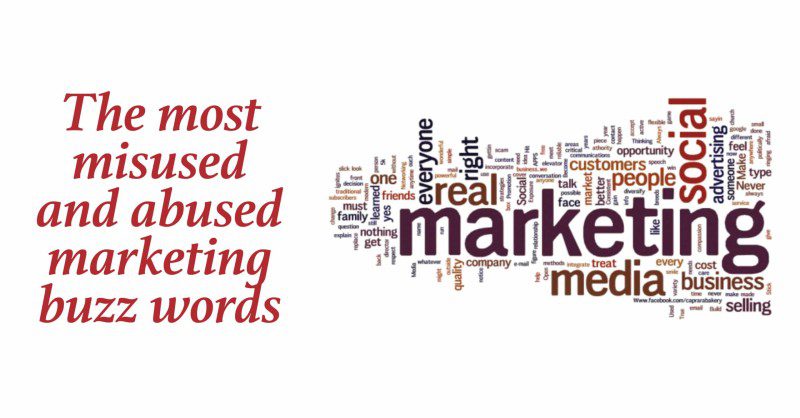On a daily basis, I hear marketing buzz words bantered about and it becomes obvious people say them and don’t really even know what they mean. I think people use sacred marketing words like relevant, equity or insights because they figure no one will challenge them. Of course, everyone puts “strategic thinker” on their Linked In profile. The problem I see is that a generation of Brand Leaders have not been properly trained and it’s starting to show.
For the past 20 years, companies have said “on the job” training is good enough. But now the lack of training is starting to show up. The misuse of these words can be linked to the lack of understanding of the fundamentals of marketing. Words always matter, but in marketing, the misuse of a word can send your brand on the wrong pathway.
The 10 most abused marketing buzz words
1. Relevant
When I ran a marketing team at J&J, I once banned the marketing buzz word “relevant” because it was so abused. I found that when a marketer would say “we need to make sure it’s relevant,” the room would go silent. Then there’s a pause, and someone would add their brilliance, “yeah, we have to be relevant.” The room went quiet again. So then I would usually ask a simple question, “so what do you mean relevant?” and sadly, that question seemed to stump most of my marketers.
Relevant has become the marketing equivalent of the word “nice” because people say it so much now, they have no clue what they mean by it. My mom and my new iPhone speakers are both “nice.” Yes, of course, marketing should be relevant. However, what exactly do YOU mean when YOU say the word relevant? When you answer the question, you likely just came up with something better. So use your specific answer of how you will be relevant instead of just blindly saying, “we need to be relevant.”
2. Awareness
Just like the word relevant, you’re just forcing me to ask, “so when we get awareness, what do we get after we get awareness?” Once you spend money, you should be able to get awareness–it’s just a question of how much money you spend. In brand terms, we don’t make any money from awareness–we only begin to make money as we can move our consumer through the consideration-search-purchase stage. So, let’s save the word “awareness” for lazy brains.
3. Brand equity
There is a good chance you are using the term “brand equity” completely wrong. The term was first coined in the 1980s as part of the RJR Nabisco take-over when they couldn’t explain why they were willing to pay a higher price than the actual book value of the assets. They didn’t know how to explain it, so they called it “brand equity” and put a dollar figure to it.
The word has strayed since in two different directions: those like Brand Finance and Interbrand who still use it to correctly attribute it to the DOLLAR VALUE of the brand and those who misuse the word when they attribute to the HEALTH or CONNECTIVITY of the brand.
Where brand equity becomes an abused marketing buzz word is when it has become a catch-all statement for the “unexplainable” feelings about a brand.
Most get it wrong
People will say, “the final scene of the TV ad is emotional and should drive brand equity.” You might mean emotions. Just say, “create an emotional bond.”
Or even worse, “It’s an equity spot.” You might mean tangible brand assets (colors, logo, slogans). Just say, “utilize our brand assets.” Or you might say, “it’s a master brand spot.”
You should look at brand health and brand wealth separately. Brand equity is brand wealth with a dollar figure. There are eight ways to drive brand wealth: premium pricing, trading the consumer up or down, reducing both product costs and marketing costs, stealing other users or getting current users to use more, entering new categories, and creating new uses for your brand. Brand wealth is not unexplainable at all.
4. Target market
I’m in shock at how badly we define the target market in the creative brief. I once read a brief with a target that said “aged 18-65, new customers, current customers, and even employees.” That pretty much covers everyone but prisoners and tourists. A well-defined target should be a combination of demographics (age, income level, male/female) and psychographics (attitude, beliefs, and behaviors). I try to put an age demographic on every brief.
The media you buy, the talent you put in the ad, the stores you choose to sell to, or even the claims you make are likely going to have an age component, so you’re just kidding yourself by saying, “we are more about psychographics than demographics.” When it comes to age, I try to push for a maximum of a 5-year gap. This type of target doesn’t mean you won’t sell to people outside of this target, but it does help give focus to you.


